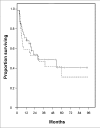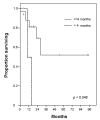High dose chemotherapy and autologous stem cell transplantation in non-Hodgkin's lymphoma: an eight-year experience
- PMID: 17066504
- PMCID: PMC2687746
- DOI: 10.3349/ymj.2006.47.5.604
High dose chemotherapy and autologous stem cell transplantation in non-Hodgkin's lymphoma: an eight-year experience
Abstract
Autologous stem cell transplantation (ASCT) is commonly used in relapsed or refractory non-Hodgkin's lymphoma (NHL). Several trials report the role of ASCT for high risk patients. We evaluated the results and the prognostic factors influencing the therapeutic effects on the patients who were treated with high dose chemotherapy (HDC) and autologous peripheral stem cell transplantation. We analyzed the data of 40 cases with NHL who underwent ASCT after HDC. Twenty- four patients had high-risk disease, 12 cases sensitive relapse, and two cases resistant relapse or primary refractory each. The median age of patients was 34 years (range, 14-58 years). The median follow-up duration from transplantation was 16 months (range, 0.6-94 months). Estimated overall survival and progression-free survival at 5 years were 40% and 30%, respectively. Poor prognostic factors for survival included older age (>/= 45 years), poor performance status in all patient analysis, and a longer interval between first complete remission and transplantation in high risk patients. In high risk NHL patients, transplantation should be done early after first complete remission to overcome chemo-resistance.
Figures



Similar articles
-
High dose chemotherapy and autologous stem cell transplantation in patients with peripheral T-cell lymphoma not achieving complete response after induction chemotherapy. The GEL-TAMO experience.Haematologica. 2003 Dec;88(12):1372-7. Haematologica. 2003. PMID: 14687990
-
Impact of three courses of intensified CHOP prior to high-dose sequential therapy followed by autologous stem-cell transplantation as first-line treatment in poor-risk, aggressive non-hodgkin's lymphoma: comparative analysis of Dutch-Belgian Hemato-Oncology Cooperative Group Studies 27 and 40.J Clin Oncol. 2005 Jun 1;23(16):3793-801. doi: 10.1200/JCO.2005.07.039. Epub 2005 Apr 4. J Clin Oncol. 2005. PMID: 15809447 Clinical Trial.
-
Autologous peripheral blood stem cell transplantation in children with non-Hodgkin's lymphoma: A report from the Korean society of pediatric hematology-oncology.Ann Hematol. 2006 Nov;85(11):787-94. doi: 10.1007/s00277-006-0169-2. Epub 2006 Aug 24. Ann Hematol. 2006. PMID: 16932891
-
Autologous stem cell transplantation in aggressive non-Hodgkin's lymphoma.Recent Results Cancer Res. 1998;144:15-26. doi: 10.1007/978-3-642-46836-0_3. Recent Results Cancer Res. 1998. PMID: 9304703 Review.
-
Autologous stem cell transplantation in aggressive non-Hodgkin's lymphoma.Hematol Cell Ther. 1996 Aug;38(4):297-304. doi: 10.1007/s00282-996-0297-0. Hematol Cell Ther. 1996. PMID: 8891721 Review.
Cited by
-
Long-Term Outcomes and Safety Trends of Autologous Stem-Cell Transplantation in Non-Hodgkin Lymphoma: A Report From A Tertiary Care Center in India.JCO Glob Oncol. 2022 May;8:e2100383. doi: 10.1200/GO.21.00383. JCO Glob Oncol. 2022. PMID: 35561291 Free PMC article.
-
Evaluation of Lymphoma Patients Receiving High-Dose Therapy and Autologous Stem Cell Transplantation: Experience of a Single Center.Indian J Hematol Blood Transfus. 2017 Sep;33(3):361-369. doi: 10.1007/s12288-016-0756-x. Epub 2016 Nov 29. Indian J Hematol Blood Transfus. 2017. PMID: 28824238 Free PMC article.
References
-
- Elias L, Portlock CS, Rosenberg SA. Combination chemotherapy of diffuse histiocytic lymphoma with cyclophosphamide, adriamycin, vincristine and prednisone (CHOP) Cancer. 1978;42:1705–1710. - PubMed
-
- Coiffier B. State-of-the-art therapeutics: diffuse large B-cell lymphoma. J Clin Oncol. 2005;23:6387–6393. - PubMed
-
- Armitage JO. Treatment of non-Hodgkin's lymphoma. N Engl J Med. 1993;328:1023–1030. - PubMed
-
- Fisher RI, Gaynor ER, Dahlberg S, Oken MM, Grogan TM, Mize EM, et al. Comparision of a standard regimen (CHOP) with three intensive chemotherapy regimens for advanced non-Hodgkin's lymphoma. N Engl J Med. 1993;328:1002–1006. - PubMed
-
- Mills W, Chopra R, McMillan A, Pearce R, Linch DC, Goldstone AH. BEAM chemotherapy and autologous bone marrow transplantation for patients with relapsed or refractory non-Hodgkin's lymphoma. J Clin Oncol. 1995;13:588–595. - PubMed
MeSH terms
LinkOut - more resources
Full Text Sources

